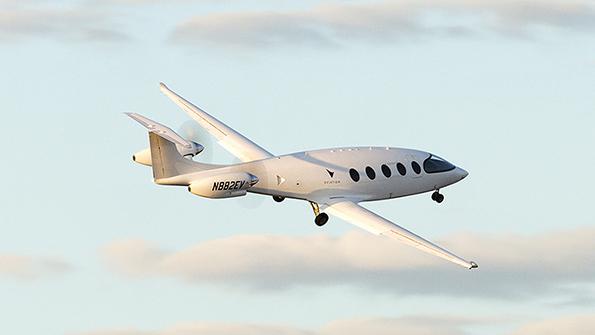
Electric aircraft promise lower-cost short-haul flights.
Anyone who has ever flown knows that the biggest hassle of airline travel is not the flying part, but the before and after.
It involves the ride to the airport, the 20-min. wait in the security line, the other 20-min. wait in line for a latte at Starbucks, the frustrating search for a place to sit down and drink your latte and then everything at the other end of the trip, including the jostle at the baggage claim and another ride to your destination.
- Global regional air mobility revenue could reach $40-65 billion by 2035
- Beating ground transportation involves more than just speed
Startups such as Ampaire and Eviation, which promise to revolutionize regional airline travel with electric-powered aircraft in a few years, and perhaps later with autonomous piloting technology, should take note of that “hassle factor,” according to recent research and analysis by consultancy McKinsey & Co.
The hassle factor is especially problematic for new regional air mobility concepts that aim to use shorter trip times and relatively lower costs—compared with historic regional airline ticket prices—to convince people to fly instead of drive on trips of about 100-500 mi.
“The beauty of a car trip is that it’s actually pretty simple,” says Robin Riedel, a partner with McKinsey who co-leads the consultancy’s Center for Future Mobility. “You get in your car, you drive and you arrive. Yes, you have to park, which is a bit of a pain, but fundamentally you have a lot of flexibility.”
The passenger experience when traveling by airline is a lot more complex and rigid, involving multiple forms of transportation—walking, driving and flying—which makes trip planning more difficult and psychologically burdensome, Riedel says.
“Once I’m settled in, there’s kind of a real calming-down moment, and so every time you break that by having to switch [transportation modes], it creates a kind of uncertainty: Where do I have to go, [and] how do I get ready for that?” he says.
Planning for all those mode switches and then performing the changes requires real mental energy. In fact, psychologists have long known that even small forms of “task switching”—for example, while creating a slide presentation, you continually check your emails—creates mental fatigue. Combined with the physical fatigue of getting to the airport with your luggage, hauling your bags onto the X-ray conveyor belt and then onto the plane, flying can be exhausting.
Changing transportation modes also adds risk. “People feel the need to buffer [extra time] because they don’t trust the smoothness of the interaction,” Riedel says. Others worry about what might get lost in transition: “I am probably going to leave my headphones behind at one of these mode changes,” he adds.
McKinsey estimates that total global revenue for regional air mobility services could amount to $40-65 billion by 2035. In the U.S., about 2.1 billion private car trips of 100-500 mi. were made in 2019, according to an estimate by McKinsey. About 2-3% of car trips could convert to regional air mobility flights, the consultancy projects. Smoothing out mode switches could increase conversion, Riedel says.
The leading appeal of regional airline travel is speed: Hybrid, electric and hydrogen-powered aircraft can cruise at more than twice the speed of a car on a highway. Regional aircraft can also use small airports, which are often closer to passengers’ origins and destinations. In the U.S., about 90% of residents live within a 30-min. drive of a regional airport and most live within a 16-min. drive of some sort of airport, according to a prior study by McKinsey.
Speed advantages of regional air mobility can quickly evaporate, however. Consider that a 143-mi. regional flight between Munich and Stuttgart, Germany, should take about 45 min. compared with 120 min. by car or even longer in rush hour traffic, McKinsey says. Yet if any glitches or delays occur with the flight, the trip could quickly go awry. For example, if a passenger waits 10 min. for a rideshare at the origin and then another 10 min. for a rideshare at the destination, their total time savings would fall by 25%. If the ride is delayed or canceled, the time advantage of flying might vanish, the consultancy says.
To address these hassle factor problems, Riedel suggests that regional airlines focus on the end-to-end passenger experience, including providing customers with information to make good plans and using software to manage transitions between transportation modes. One idea is to integrate flight status data into rideshare apps to guarantee a ride is waiting when a passenger lands.
Building such an end-to-end trip transportation app would be no simple feat, especially for an industry that has struggled with building digital customer experiences.
“The airlines don’t really lend themselves to that,” Riedel says. “It’s not like they’re [known for being] digitally awesome or customer experience awesome. Who’s going to figure it out for air mobility?”
